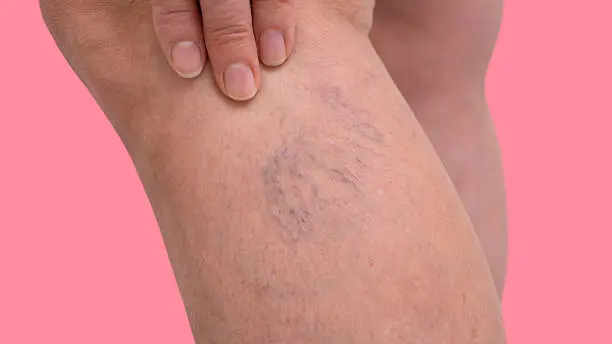Varicose veins are a common problem among older women, as veins are affected by age-related changes and weakening of blood vessel walls.
Although not usually a serious condition, they can cause discomfort and pain, impacting quality of life. Many treatment methods are available today to help alleviate symptoms and improve the appearance of the legs effectively and safely.
Varicose Veins in Older Women and Their Causes

Understanding the causes of varicose veins in women is crucial for effective treatment. They appear as a result of vein dilation and blood reflux due to:
- Weakening of vein valves with age.
- Lack of physical activity and weight gain.
- Genetic factors.
- Prolonged standing.
Symptoms of Varicose Veins and Their Impact on Life
Symptoms of varicose veins in women range from minor cosmetic concerns to significant pain and swelling, including:
- A feeling of heaviness or pain in the legs.
- Swelling of the ankles and nighttime cramps.
- The appearance of blue or purple veins.
- Itching or inflammation around the affected vein.
Diagnosis of Varicose Veins in Older Women
The diagnosis of varicose veins in women relies on a physical examination by a doctor and some painless tests, including:
- A clinical examination of the legs.
- An assessment of lifestyle and symptoms.
- An ultrasound of the veins.
- Determining the extent of blood reflux and the severity of the condition.
Non-Surgical Treatments for Varicose Veins
Non-surgical treatments for varicose veins in women are the first choice, especially for older women, and include:
- Wearing compression stockings.
- Elevating the legs when sitting.
- Engaging in light exercise such as walking.
- Losing weight to maintain healthy blood pressure.
Minor Interventional Treatments
These are effective procedures for treating varicose veins in women and do not require general anesthesia. They include:
- Sclerotherapy, which involves injecting a substance that closes the vein.
- Superficial laser treatment for small veins.
- Radiofrequency ablation.
- Vein closure using a special medical adhesive.
Surgical Treatment in Advanced Cases
Surgical treatment is used when varicose veins in women are severe or unresponsive to non-surgical treatment. It includes:
- Litigation and removal of the affected superficial vein.
- Vein stripping surgery.
- A minor surgical procedure to remove prominent veins through tiny incisions.
Lifestyle and its role in reducing progression

Lifestyle changes help prevent the worsening of varicose veins in women and improve treatment outcomes. These changes include:
- Avoiding prolonged sitting or standing.
- Practicing exercises to improve blood circulation.
- Eating a fiber-rich diet to reduce pressure on the veins.
- Drinking enough water daily.
Frequently asked questions about varicose vein treatment in women
Are compression stockings effective in treating varicose veins in women?
Yes, they help improve blood flow and relieve symptoms, especially when used regularly.
Can varicose veins recur in women after treatment?
They may recur in some cases, especially with genetic factors or if a healthy lifestyle is not maintained.
Are interventional treatments for varicose veins safe for older women?
Most of these procedures are safe because they are performed without general anesthesia and recovery time is quick.
When should older women see a doctor if they have varicose veins?
If severe swelling, sudden pain, or a change in skin color around the vein occurs.
Article Summary
Varicose veins are a common problem among older women, but they are manageable and treatable through various methods tailored to different cases.
Options range from conservative approaches such as compression stockings and lifestyle modifications to modern interventional treatments or surgery when necessary. Early diagnosis and medical follow-up help avoid complications and significantly improve quality of life.